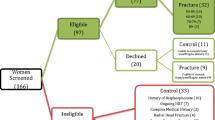Abstract:
Bone loss occurs close to a fracture and is associated with increased bone turnover. Fracture healing itself results in increased markers of bone turnover. But the exact patterns of these changes after different fractures are unclear. We aimed to investigate the changes in bone density and biochemical markers following distal forearm fracture. Twenty women (mean age 63 years) were recruited following fracture of the distal radius and ulna. Bone mineral density (BMD) of the hand and forearm were measured by dual-energy X-ray absorptiometry (DXA) and quantitative ultrasound (QUS) of the fingers was measured at 0, 6, 12, 26 and 52 weeks after fracture. Serum and urine samples were collected at 0, 3 and 7 days and at 2, 4, 6, 12, 26 and 52 weeks after fracture to measure markers of bone turnover. For bone formation we measured: bone alkaline phosphatase (iBAP), osteocalcin (Oc), procollagen type I N-terminal propeptide (PINP); and for bone resorption: tartrate-resistant acid phosphatase (TRAcP), free deoxypyridinoline (iFDpd), N-telopeptides of type I collagen (NTx). We used the nonfractured limb to calculate values for baseline BMD and amplitude-dependent speed of sound (AD-SoS). There was a decrease in BMD at the hand and in AD-SoS of the fingers after forearm fracture (p<0.001). This bone loss was maximal for BMD by 6 weeks at 9% (p<0.001) and remained decreased at 52 weeks. AD-SoS decreased at 12 weeks by 3% (p<0.01) and recovered completely by 52 weeks. Bone formation markers increased between 2 and 4 weeks by 13–52% (p<0.001), and were still elevated at 52 weeks. Bone resorption markers increased between 2 and 6 weeks by 18–35% and returned to baseline at 52 weeks (TRAcP remained elevated). We conclude that BMD decreased distal and immediately proximal to the fracture line when measured with DXA and QUS. Bone loss after distal forearm fracture did not recover by 52 weeks and most bone turnover markers did not return to baseline.
Similar content being viewed by others
Author information
Authors and Affiliations
Additional information
Received: 27 January 1999 / Accepted: 19 April 1999
Rights and permissions
About this article
Cite this article
Ingle, B., Hay, S., Bottjer, H. et al. Changes in Bone Mass and Bone Turnover Following Distal Forearm Fracture . Osteoporos Int 10, 399–407 (1999). https://doi.org/10.1007/s001980050246
Issue Date:
DOI: https://doi.org/10.1007/s001980050246




